Do you want to skyrocket your business success and take it to the next level? Are you eager to expand your customer base and create a better product? Then, it’s time to start listening to your customers! This article will explain how you can use customer feedback as a powerful tool to help your business grow. We’ll look into how handling customer inquiries can help you understand their needs and create improved services and products. So, if you’re ready to see your customer engagement autopilot in action, keep reading to achieve your goals!
Understanding What Customers Want to Say
Once turning into a consumer, one’s expressions take on an array of forms, ranging from inquisitive to scathing. They are the lifeblood of successful businesses, providing the opportunity to build strong relationships with customers and uncover solutions to their challenges.
Whether it’s an inquiry about a product, a service, or an issue, opinions are a valuable source of feedback and insight. Knowing what your customers are looking for and how they want to receive it can help you provide better service and build customer relationships.
Asking questions and listening to feedback can act as a driving force in eliciting what customers want. Analyzing customer data can also provide significant insights into customer psychology. Finding ways to improve customer experience and satisfaction is key to meeting customer needs. Taking the time to understand customer needs is a surefire way to define the best possible customer experience.
- Power of Customer’s Voice: Are you ready to unlock the power of customer feedback? Hearing customers’ voices can help you understand their psychology toward your product. It eventually turns them into loyal customers which is the jackpot to reap the rewards and gain a competitive edge. Let’s discover what and how much this superpower has to offer you in return.
- The Benefits of Open Communication: Running a business means you always have to ensure that your customers have a comfort zone when it comes to interacting with you. This involves giving them time to express their opinion on anything, even the tiniest matters are not neglected here. Doing so helps to build trust and strengthen the customer-business relationship, fostering a positive environment for the business to grow and thrive.
- Quality Customer Service: Responding to customers is not only limited to building trust but also works behind the scenes to ensure that customers are getting the best service as per their needs. Being friendly with customers, and having accurate responses let customers know that their concerns are taken seriously and that their needs are being taken into consideration.
- Gaining Customer Satisfaction: When customers feel like their inquiries are being addressed and that their questions are being answered in a timely and efficient manner, it can lead to an overall increase in customer satisfaction. This is important for any business, as satisfied customers are more likely to keep coming back and recommending the business to others.
- Improved Customer Retention: When customers are provided with quality customer service and their inquiries are addressed in a timely and effective manner, it can lead to a decrease in customer churn. This is beneficial for any business, as it helps to ensure that customers remain loyal to the business and continue to make purchases and recommendations.
- Increased Revenue: Ultimately, customers’ opinions can lead to an increase in sales and revenue. Let customers know you’re listening! You will be stunned to see how much this feeling of being taken seriously can do. Your product will just be one step away from going viral. This, in turn, can lead to higher revenue and greater success for your company.
7 Types of Customer Inquiries
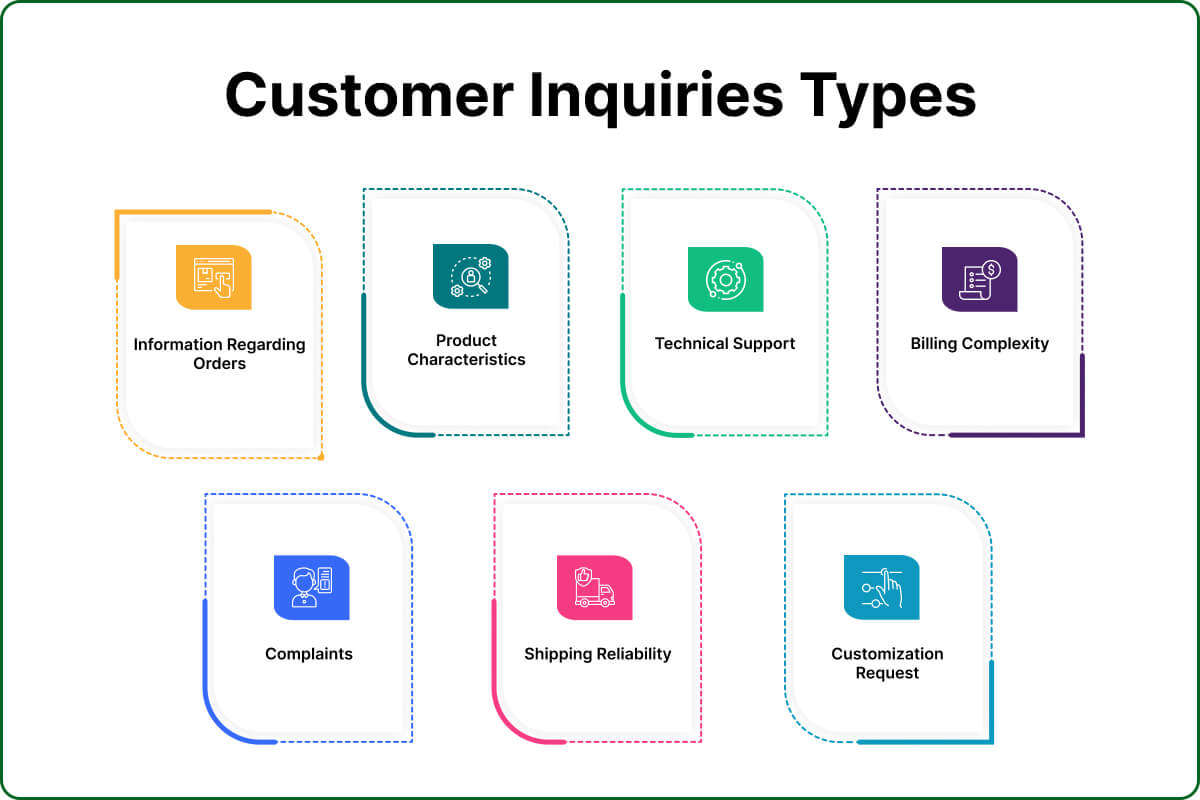
- Information Regarding Orders: This is the very first inquiry that customers may have related to their purchases. This could include questions related to the order status, tracking numbers, and product availability. Customers may have difficulty with placing orders, understanding order confirmations, or issues related to payment. Additionally, buyers may wish to inquire about discounts, promotions, or shipping fees associated with their orders.
- Product Characteristics: These questions are usually related to the size, quality, materials, safety, compatibility, durability, energy efficiency, and other features of the product. Customers want to know what they are getting before they make a purchase, so they ask questions to make sure they get the best product or service for their needs. By getting the answers to these questions, customers can ensure that they make the best purchase for their needs.
- Technical Support: Customers may ask about the availability of the service if there is a cost for the service, what type of support is offered, what the turnaround time is for resolution, and if there are any specific guarantees. The question can also come up with the inquiry about the level of expertise of the technicians and what type of equipment is required for the service. Additionally, customers feel the necessity to learn how to use a certain tool or feature, what the limitations of the product or service are, or how to make the most of it.
- Billing Complexity: This is obvious for customers to better understand how they are being charged. Common billing questions include things like what are the payment terms, what are the fees associated with their payment method, and if there is a minimum purchase requirement. The inquiries may also be packed with what the return policy is and if there is a grace period for late payments.
- Complaints: It’s no secret that customers can be vocal when they’re unhappy or have experienced a problem. Issues related to product quality, delivery, payment, and customer service are all common complaints that customers may have. Customers may find it difficult to understand complex billing terminology, fees, and charges that are often included on invoices. Moreover, some may lose their way to access the service or not be able to get help with their purchase.
- Shipping Reliability: This could include questions about the cost of shipping, estimated delivery times, and tracking information. Customers may also want to know about packaging, customs fees, and other associated costs. Nowadays, it’s usual that they worry about the safety of their items during shipping, or any potential delays.
- Customization Request: This case is often used for businesses looking for a competitive edge, as it allows them to offer a product that is exactly tailored to the customer’s needs. This process typically involves modifying the product or service in some way, such as adding features, changing the design, or even providing additional services. For instance, people may ask for a particular color, size, or shape of a product.
How to Respond to Customer Inquiries
Whether you’re a customer service representative or a business owner, it’s important to be able to respond to customer inquiries in a timely and professional manner. From providing personalized responses to utilizing automation, there are various methods of receiving customers and making them feel welcome. Let’s dive in and explore how you can satisfy your customer when they come up with something to say!
Five Steps to Win a Customer Call
So it turns out that to keep the sales line intact, you have to embrace the barrage of customer queries. You must be wondering now about how to handle customer inquiries. Fortunately, this is nothing new in the business world. Rather, countless endeavors have been going on to gain mastery in this area for ages. These 5 simple steps will help you win any customer call.
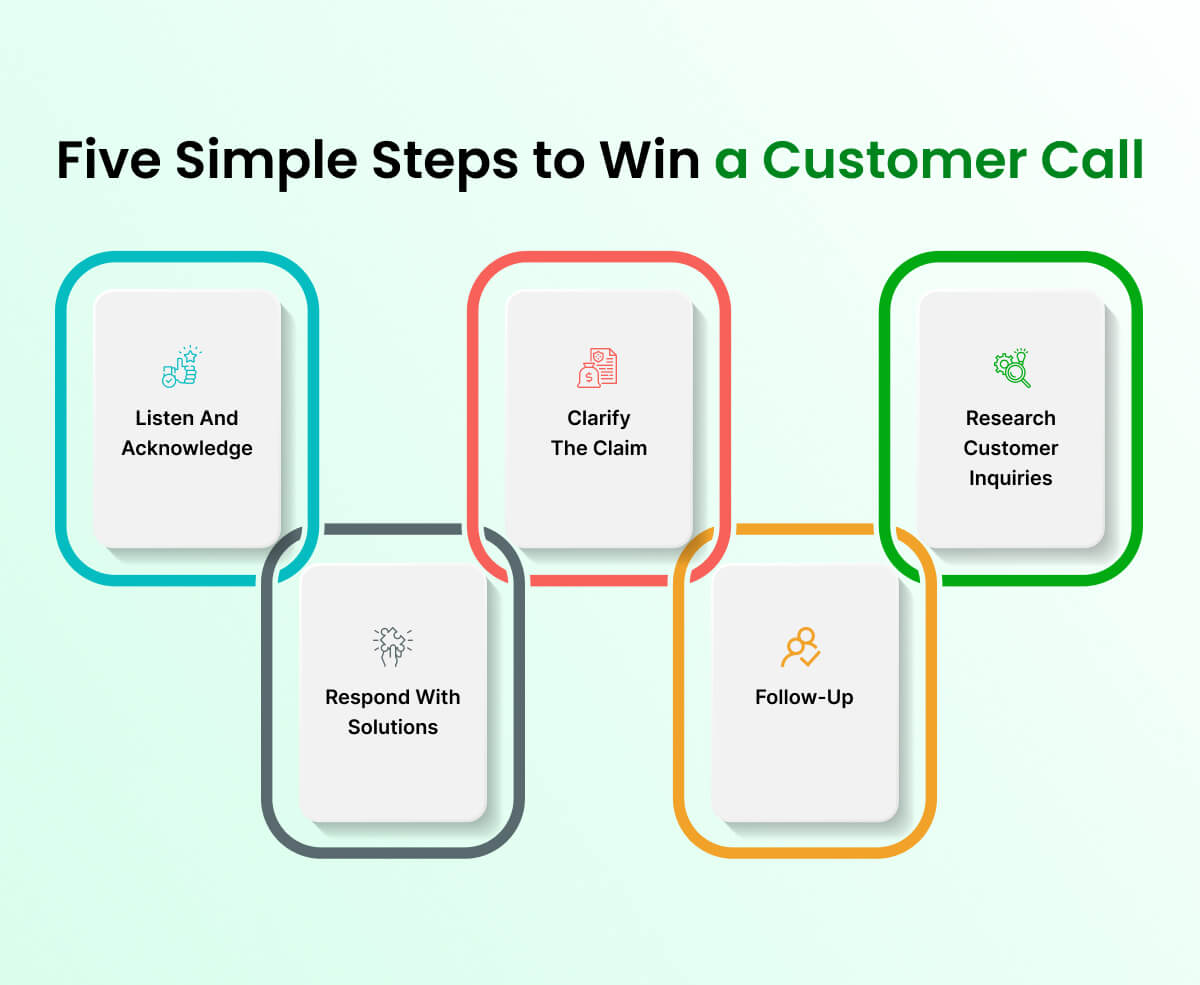
- Listen and Acknowledge: When taking customer queries, the first step should be to listen closely to what the customer is saying. Acknowledge their inquiry, and thank them for bringing it to your attention. This leaves customers in no doubt that you take their word seriously.
- Clarify the Claim: After listening to the customer, it is important to clarify the inquiry by asking questions, which will help to ensure that your response is accurate and appropriate. This will also help to ensure that you are addressing the customer’s exact needs.
- Research Customer Inquiries: Once the inquiry has been clarified, to respond to the customer properly, it is important that you first clear yourself by doing thorough research on the issue. This could include looking up relevant information, reading customer reviews, or consulting with experts in the field.
- Respond with Solutions: After researching the inquiry, it is important to respond with solutions. This could include providing the customer with a product or service they may need or offering advice on how to address their issue. Be sure to provide the customer with clear instructions on how to proceed.
- Follow-Up: The last step is to follow up with the customer until the problem-free stage so that they know exactly when they are free to use it. This process may involve sending an email or calling them with a confirmation message to resolve the issue. Doing this will help to ensure that the customer is satisfied with the response they have received and that their inquiry has been properly addressed.
Things You Should Avoid While Attending Customer Inquiries
This is obvious that talking to customers is tricky, especially when you’re trying to juggle a lot of them at once. To help you stay on the route, here are the things you should put aside while attending to them.
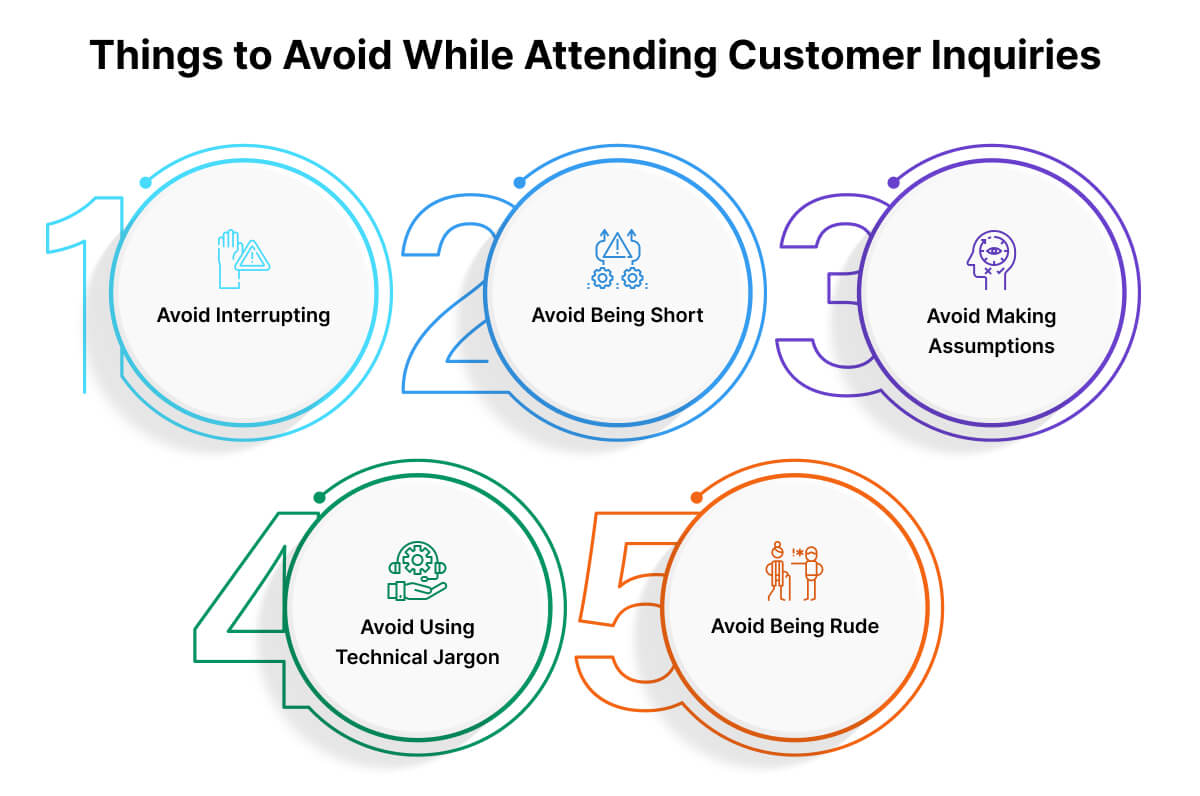
- Avoid Interrupting: Interrupting the customer when they’re speaking is one of the quickest ways to make them feel unheard and disrespected. Instead, ensure that you’re actively listening to the customer and letting them finish their thought before you interject.
- Avoid Being Short: Customers want to feel like their issue is being taken seriously, so be sure to avoid using short, curt responses when responding to their inquiries. Instead, take the time to provide a thorough response and be sure to let the customer know that their issue is being addressed.
- Avoid Making Assumptions: It’s important to remain neutral when dealing with customers and never make assumptions about the customer or the situation. Always take the time to fully understand the customer’s issue and provide an appropriate response.
- Avoid Using Technical Jargon: While it’s important to be knowledgeable about the products and services your company offers, avoid using technical jargon when talking to customers. Not everyone is familiar with industry terminology, so you should use words that are easy for everyone to understand.
- Avoid Being Rude: Even if the customer is being rude or aggressive, it’s important to stay professional and courteous. Avoid responding in kind and instead focus on resolving the customer’s issue politely and respectfully.
5 Key Skills for Answering Customers
Do you want to create a memorable experience for your customers? Then you’ll need to exercise some communication skills. By having the right skills, you can ensure that customers feel appreciated and valued. Read on to learn how to become a customer service master!
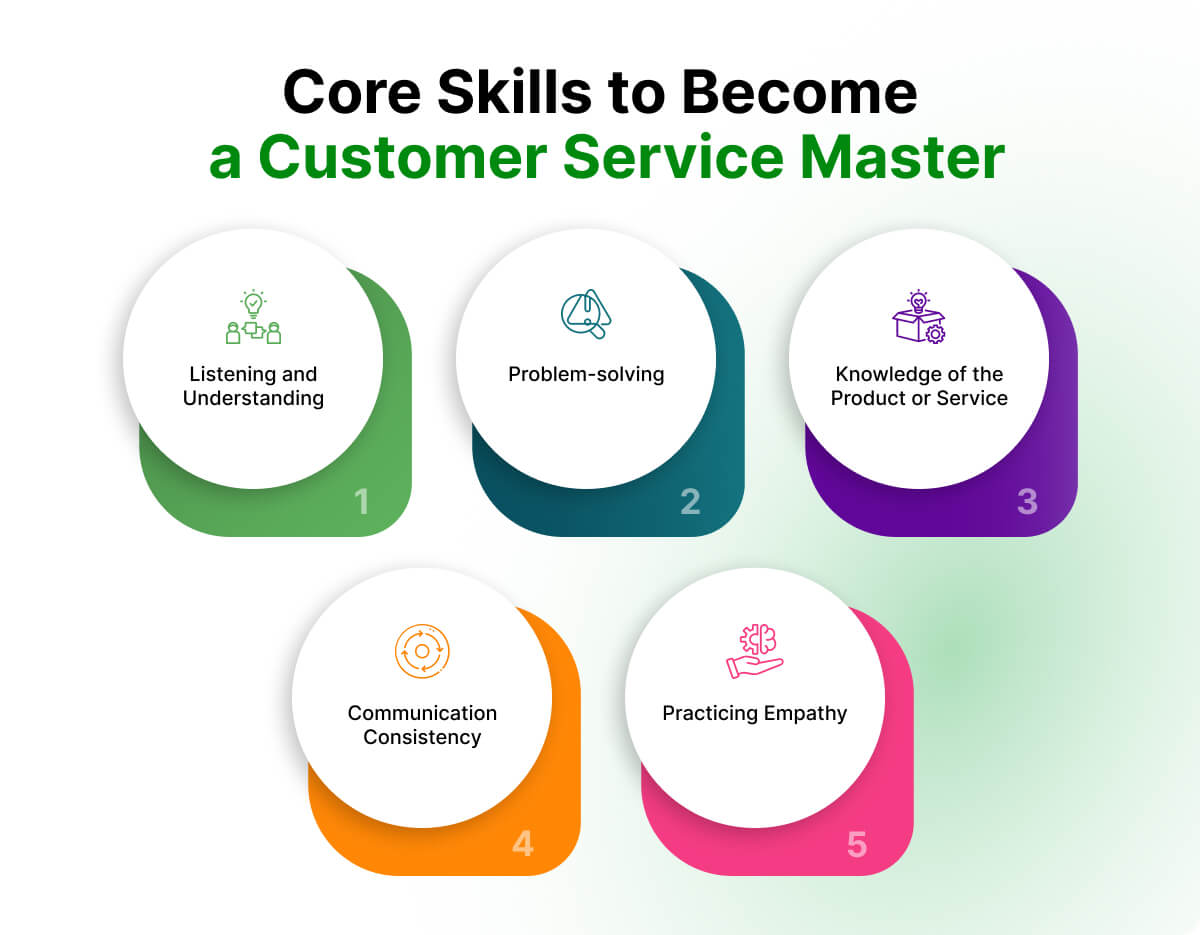
- Listening and Understanding: Precisely understanding the customer as well as proper listening is itself a skill that plays a pivotal role in responding the right way. When engaging in conversation with customers, it is important to focus on their needs and respond in a way that is appropriate for the situation. When you go about your active listening practice, you need to give your undivided attention to what the customer is saying. Understanding their message, and responding with appropriate questions and comments will spontaneously be in order.
- Problem-Solving: This strength can help a business afford long-term customer relationships. This involves being able to think critically and analytically to identify the customer’s issue and provide an appropriate solution. At this time you need to demonstrate your ability to quickly assess the situation and come up with immediate solutions.
- Knowledge of the Product or Service: Without this expertise, all attempts will be wasted which will adversely affect the branding. Customer service officers must be familiar with the product or service they are providing, as well as the industry they work in. This proactivity helps them to accurately answer every customer query in a very short period.
- Communication Consistency: Being able to communicate effectively is necessary for each and every sphere of the business arena. This involves being able to use verbal and written communication to explain product and service features, answer customer questions, and provide helpful advice. Additionally, you must maintain a professional, friendly, and respectful persona in such communications.
- Practicing Empathy: If you wish to get on to your customers, you need to sync yourself with their psychology. When they are complaining, maintaining reasonable empathy will make it easier for you to think of their concerns from their perspective. This ability to empathize allows you to be more patient and engage with customers which can lead to winning the deal.
4 Challenges of Customer Support
With the ever-changing consumer demands and expectations, customer support is becoming increasingly complex. From small businesses to enterprises, business owners and customer support teams can’t help when facing obstacles. Let’s analyze some challenges that we have to spend a very difficult time dealing with.
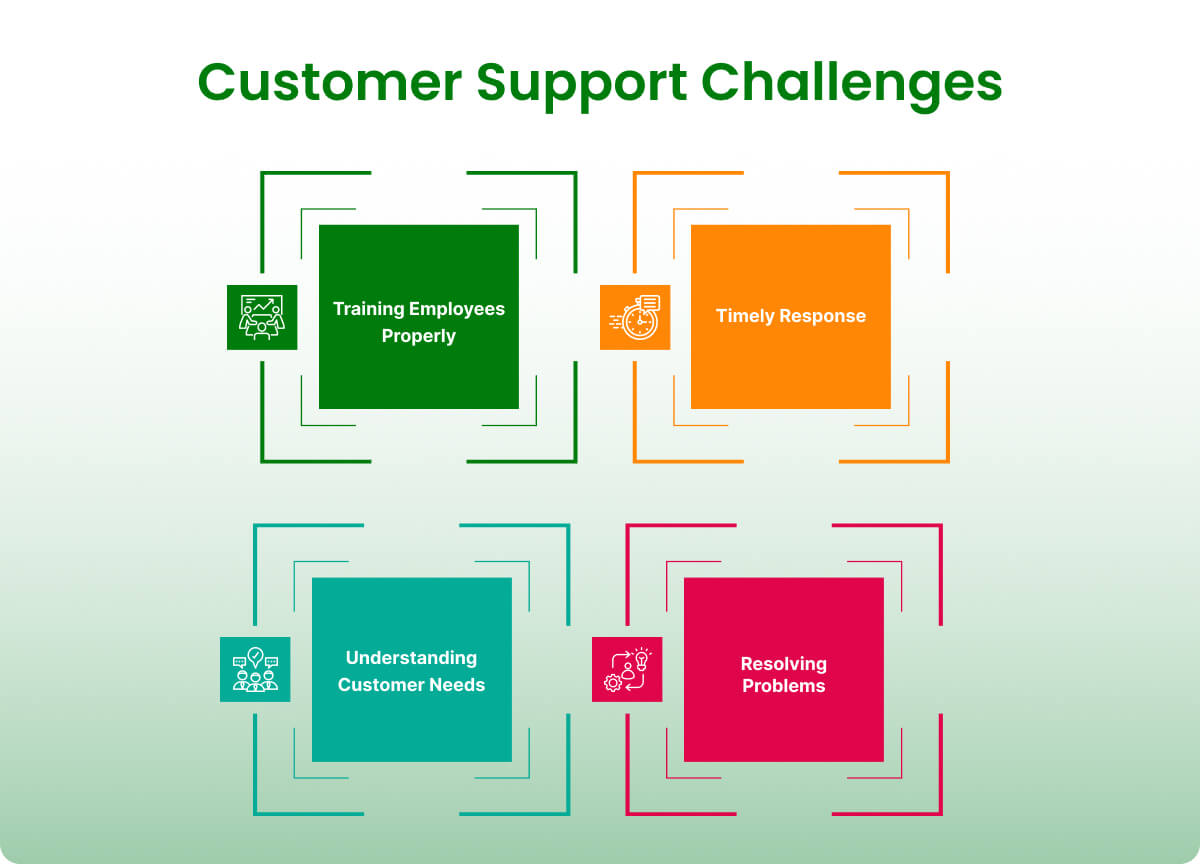
- Training Employees Properly: It’s not enough to just instruct employees regarding customer care. They need to be trained on how to respond to different types of inquiries, and how to provide helpful solutions. It needs to set a customer inquiries example to demonstrate the process in front of them. It takes time and effort to properly train employees, and it can be a challenge if you don’t have the resources or personnel necessary to do so.
- Timely Response: Customers expect a prompt response, and if they don’t get one, they may become frustrated and take their business elsewhere. This can be a challenge if your business doesn’t have enough staff to quickly respond to every one of them, or if your staff is overloaded with other tasks.
- Understanding Customer Needs: Customers often have specific needs and expectations when they make inquiries, and businesses need to understand these needs to provide the best possible service. This can be a challenge, as it requires businesses to understand the customer’s background, their needs and wants, and their expectations. It can also be difficult to determine the best course of action for each customer, as what works for one customer may not work for another.
- Resolving Problems: It’s not always easy to figure out what the customer needs or what the best solution is. The customer might not be sure what the issue is, or they may not have all the information needed to provide a full picture of the issue. However, inquiries can involve multiple layers of complexity and may require a deep understanding of the customer’s context and situation. For instance, if a broadband internet customer has trouble getting an internet connection, for the first time, checking its data loss is a normal service. If all the devices supplied by the company are okay, it is a bad service to advise the customer to change his/her router without thinking. On the contrary, a good service provider will send technicians to the customer’s end to check the connection with a spare router.
Tools for Better Customer Inquiries Management
As customer requests become more complex and varied, businesses need to have efficient tools for managing the inquiries that come from customers’ end. With the right tools, a better customer experience can be ensured within no time. Let’s enlighten ourselves about some really handy customer grievance automation software.
- Customer Relationship Management (CRM): This software comes with a pack of tools that can manage the directory for all of your customer interactions, as well as follow up with them and monitor customer satisfaction. Plus, you can easily create reports and analyze customer trends to decide for your company in a long run.
- Ticketing System: It allows you to track customer inquiries from start to finish, so you know exactly what is going on with each one. Plus, you can assign inquiries to the right team members, so you can be sure that inquiries are being handled quickly and efficiently.
- Chatbot Software: Chatbots can be programmed to answer common queries of customers. It’s like traveling to an unknown place without even knowing it. The tourists don’t even need any human guide to exploring around. You can turn this bot into an efficient front desk face that can save you from hiring heads if you can properly utilize it.
- Social Media: When it comes to branding, this platform can give you a leg up on a lot of competition. An extensive array of product promotions, combined with a comprehensive group and page bursting with product-related info, ensures no customer query goes unanswered. Not to mention increasing opportunities to engage with customers, where you can make more personal connections than any other medium. And, if done well, you can even turn customers into loyal fans!
Over to You
Finally, it is very natural for customers to enjoy your good service in silence, but if they find a mole of errors, the customer will become critical. Now you can consider that criticism and make your product more acceptable to that critical customer. There is no substitute for having a dedicated system for brainstorming customer issues. Doing so is a worthwhile investment for any company, as it will surely add more figures to the statistics of returning customers as a result of a satisfactory experience. Taking time to answer customer inquiries as well as instant responses can help prevent potential problems from escalating, and keep customer loyalty high.
This is Kawser Md Sayem, and I would like to introduce myself as a content writer. It has been five years since I began my professional writing journey. By this time, I have had the pleasure of working in unidentical industries like publishing, information technology, entertainment, and education
 Customer Support
Customer Support






